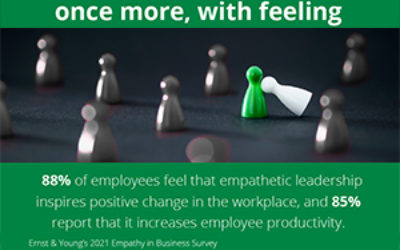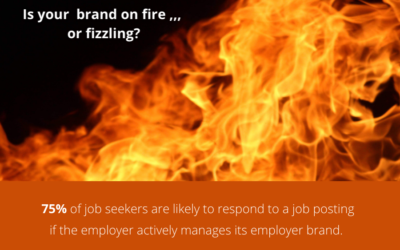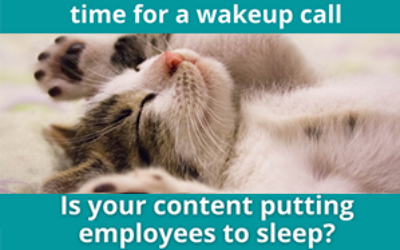A culture in which employees feel respected and included can have a significant impact on both their ability to thrive and their incentive to contribute. According to a 2021 BetterUp study, workplace belonging leads to a 56% increase in job performance, 50% lower turnover risk and 75% fewer employee sick days. If you want to build a culture of belonging, but don’t know where to begin, check out these ideas to get started. Learn more
We love to share our insights (but not our popcorn).

Build a Culture of Belonging, One Step at a Time

Engaging Your Hybrid Team
According to a 2023 Gallup study, 52% of U.S. full-time, remote-capable employees are in a hybrid work arrangement, yet 70% of managers report that they have had no formal training in how to lead a hybrid team. To engage and build trust with a hybrid workforce, managers will need to be even more flexible, creative and resourceful. Learn more

How to Disagree Without Discord
Even colleagues who agree on most issues may have different points of view from time to time. But unlike the all-too-common experience on social media, exchanging opposing ideas doesn’t have to become a free-for-all. With some common sense guidelines, you can express your view — and listen to those of others — with respect, positivity and professionalism. Learn more

Is Your Recruiting Strategy Ready for Gen Z?
A study by Snap Inc./Oxford Economics finds that Gen Z will be a dominant force in the workplace by 2030. Make sure your recruiting strategy is designed to engage this group and provide what they want in a job. Learn more

Lead through Partnership, Not Power
Since the advent of the pandemic, much has been written about the shifting balance of power between employers and the workforce. While power dynamics have always been present in the labor market, don't let this growing emphasis on corporate power color your leadership style. Effective leaders keep their focus on we and us, not on me and them. Learn more

Building a Culture of Mental Health
Employee mental health was a rising concern pre-pandemic and has now reached crisis proportions. According to the World Health Organization, depression and anxiety are estimated to cost the global economy $1 trillion each year due to lost productivity. Creating a positive mental health culture should be a core component of your business strategy. Learn more

Quiet Quitting and Rekindling the Fire
No matter what you call it — quiet quitting, acting your wage or coasting — it’s clear that workers today have different views about what engagement looks like. Here are some thoughts to help organizations and employees find a path forward. Learn more

The Power of Storytelling in Public Speaking
Anyone who has watched a great TED talk can attest to the power of storytelling to connect, engage and instruct. In fact, a 2021 McKinsey Global Institute study includes storytelling, particularly in the context of public speaking, among the 56 foundational skills essential to compete in the future workplace. Learn more

5 Success Factors for Employee Surveys
The pandemic created a seismic shift in what people now value, both in a job and in an employer. A survey can be a valuable tool for helping you identify what your current and prospective employees want and need. Learn more

Supporting Managers in a Changing Workplace
According to a 2021 Gartner study, 68% of HR leaders say managers are overwhelmed by their responsibilities, yet only 14% of companies are addressing the situation. See how you can support your managers to lead successfully. Learn more

Stack Your Deck in the Great Reshuffle
Companies work so hard to attract good people, then let them down with a poor onboarding process. Learn how to build the foundation for a great employee experience with a smart onboarding strategy. Learn more

6 Tips for Onboarding Success
In its 2019 study, Gallup found that only 12% of employees strongly agree that their organization does a great job of onboarding new employees. See our tips for setting new hires up for success. Learn more

Once More, with Feeling
Some leaders are empathetic by nature; others need training, tools and mentoring to get there. Make sure you offer leaders the resources to evolve and grow, so your organization can thrive. Learn more

5 Ways to Lead with Empathy
Studies show that empathetic leadership is critical to employee productivity and engagement. While empathy comes naturally to some individuals, others will need training and mentoring to become empathetic leaders. Learn more

5 Tips for Communicating Your Employer Brand
According to a 2021 Glassdoor survey, 75% of active job seekers are likely to respond to a job posting if the employer actively manages its employer brand. With more waves of the Great Resignation likely to come, you’ll want to ensure your employer brand messaging is on point to attract, and retain, the talent you need. Learn more

6 Steps for Getting Gen Z Benefits-Savvy
Over the next 10 years, Gen Z will account for more than 60 million job seekers, a large portion of the labor market, according to data from Concordia St. Paul University. Understanding this audience’s benefits needs and priorities will be important for employers. Learn more

5 Tips for Year-Round Benefits Education
According to a recent survey by Voya Financial, 66% of employees now want their company to provide more benefits information outside of open enrollment. Having a year-round benefits communications strategy will help meet this growing interest in benefits education. Learn more

Time to Reignite Your Employer Brand
With employees expecting a richer, more fulfilling work experience, is your business able to stand out from the crowd? Learn how to make your employer brand shine bright. Learn more

5 Ways to Promote Healthy Employee Engagement
Cultivating employee engagement is integral to enhancing health and wellbeing for all employees. A collaborative approach to building engagement helps ensure you provide what employees truly want and need to feel, and perform at, their best. Learn more

Time for a Wakeup Call
Like good health habits, good communication habits are easy to understand…and easy to forget. Check out our refresher on engaging employees with your benefits communications. Learn more

6 Tips for Managing a Hybrid Team
Many companies are transitioning to a hybrid workplace, with some employees returning to onsite work and others continuing to work from home. Knowing how to keep everyone informed, connected and working as one team is critical to businesses moving forward. Learn more

Time to Reboot Your Employee Value Proposition (EVP)
The challenges of the global pandemic have forced organizations to rethink and reshape their businesses in many ways. One area that needs reexamination is your organization’s Employee Value Proposition (EVP). Make sure your EVP connects to what employees want in a company today. Learn more

Diversity: Moving from Concept to Commitment
Each week, more and more businesses are beginning to take a stand on social justice issues and support diversity and inclusion (D&I) efforts. With a sound communications approach, you’ll ensure that your D&I strategy is more than just eloquent words. Learn more

Facing Workplace Reentry Challenges
Companies that plan to return their employees to onsite work face challenges on several fronts. Taking a big-picture perspective will help ensure you’re doing all you can to help employees feel safe. Learn more

Bringing Workplace Values to Life
Values. They’re more than a CEO sound bite on the evening news or a glossy poster in the breakroom. Workplace values can determine your company’s culture and have a direct impact on its bottom line. With a smart communications strategy, you can bring those values to life. Learn more

Bridging the Culture Gap During a Merger
While mergers offer several advantages — increased market share, economies of scale — these potential gains quickly diminish if there are significant cultural differences between the two parties. Communications can bridge the culture gap and ensure a smooth transition for new employees. Learn more

